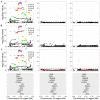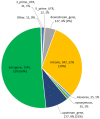New loci and neuronal pathways for resilience to heat stress in cattle
- PMID: 34404823
- PMCID: PMC8371109
- DOI: 10.1038/s41598-021-95816-8
New loci and neuronal pathways for resilience to heat stress in cattle
Abstract
While understanding the genetic basis of heat tolerance is crucial in the context of global warming's effect on humans, livestock, and wildlife, the specific genetic variants and biological features that confer thermotolerance in animals are still not well characterized. We used dairy cows as a model to study heat tolerance because they are lactating, and therefore often prone to thermal stress. The data comprised almost 0.5 million milk records (milk, fat, and proteins) of 29,107 Australian Holsteins, each having around 15 million imputed sequence variants. Dairy animals often reduce their milk production when temperature and humidity rise; thus, the phenotypes used to measure an individual's heat tolerance were defined as the rate of milk production decline (slope traits) with a rising temperature-humidity index. With these slope traits, we performed a genome-wide association study (GWAS) using different approaches, including conditional analyses, to correct for the relationship between heat tolerance and level of milk production. The results revealed multiple novel loci for heat tolerance, including 61 potential functional variants at sites highly conserved across 100 vertebrate species. Moreover, it was interesting that specific candidate variants and genes are related to the neuronal system (ITPR1, ITPR2, and GRIA4) and neuroactive ligand-receptor interaction functions for heat tolerance (NPFFR2, CALCR, and GHR), providing a novel insight that can help to develop genetic and management approaches to combat heat stress.
© 2021. The Author(s).
Conflict of interest statement
The authors declare no competing interests.
Figures







References
-
- Li, D., Yuan, J. & Kopp, R. B. Escalating global exposure to compound heat-humidity extremes with warming. Environ. Res. Lett. 15, 064003 (2020).
-
- St-Pierre N, Cobanov B, Schnitkey G. Economic losses from heat stress by US livestock industries. J. Dairy Sci. 2003;86:E52–E77. doi: 10.3168/jds.S0022-0302(03)74040-5. - DOI
Publication types
MeSH terms
LinkOut - more resources
Full Text Sources

